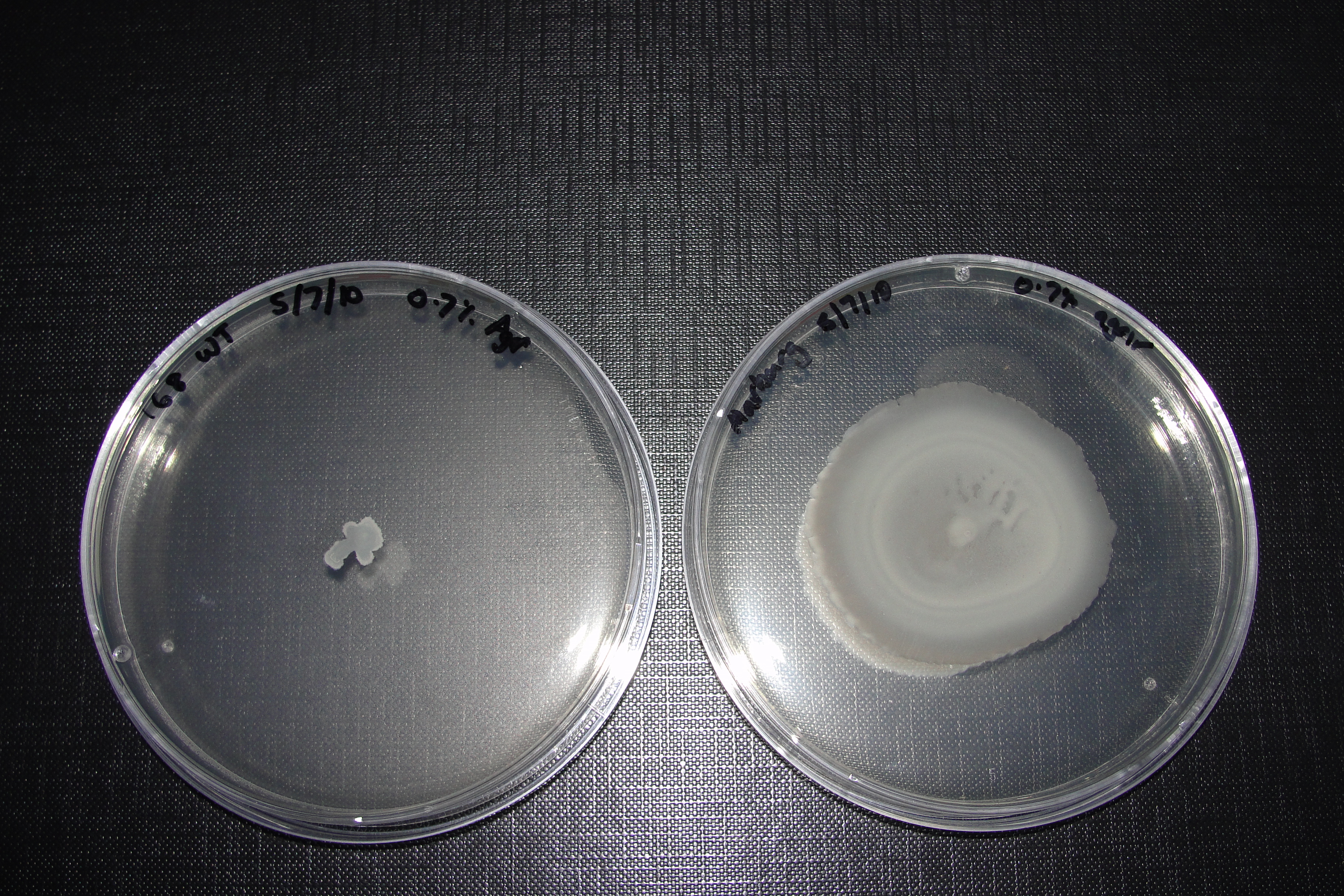Team:Newcastle/Swarming
From 2010.igem.org
Shethharsh08 (Talk | contribs) |
Swoodhouse (Talk | contribs) (→Swarming biobrick) |
||
| (43 intermediate revisions not shown) | |||
| Line 1: | Line 1: | ||
{{Team:Newcastle/mainbanner}} | {{Team:Newcastle/mainbanner}} | ||
| - | =Swarming= | + | ==Swarming== |
| - | + | ||
| - | + | Our project requires ''Bacillus subtilis'' 168 to swarm along the cracks to the site of repair. However | |
| - | # | + | it is known that the domesticated ''Bacillus subtilis'' 168 is not unable to swarm on a solid surface eg. agar plate, while the undomesticated ''Bacillus subtilis'' 3610 exhibit swarming properties (Figure 1). The swarming properties requires two factors, the flagella, which serves as a propeller to push the bacteria forward. And the production of surfactin, which is a natural surfactant which helps in reducing surface tension. In ''B. subtilis'' 168, both genes that are involved in the process, ''swrA'' and ''sfp'' have undergone frameshift mutation, therefore they are defective. As such, our team have decided to repair the genes by designing a biobrick that contain both genes. |
| + | |||
| + | [[Image:Newcastle_swarming.jpg|centre|400px]] | ||
| + | |||
| + | '''Figure 1:''' Agar plates are inoculated with either ''B. subtilis'' 168 (left) or ''B. subtilis'' 3610 (right) and incubated overnight at 37°C. | ||
| + | |||
| + | ===Swarming part=== | ||
| + | |||
| + | [[Image:Newcastle Swarming biobrick.png|centre]] | ||
| + | |||
| + | |||
| + | The swarming biobrick consists of the ''sfp'' and ''swrA'' gene under a constitutive promoter, Pveg. The expression of ''sfp'' would allow the post translational modification of the immature surfactin peptide encoded by the ''srfABCD'' operon. The mature surfactin is then transported out of the cell, to reduce surface tension. The ''swrA'' gene helps in the biosynthesis of flagellum. ''swrA'' acts on the the gene ''sigD'', which in turn acts as a transcription for the genes required in the late flagellum biosynthesis. Together, surfactin and the flagella will allow swarming to occur. | ||
| + | |||
| + | This part is [http://partsregistry.org/wiki/index.php?title=Part:BBa_K302016 BBa_K302016 on the parts registry]. | ||
| + | |||
| + | ===Bibliography=== | ||
| + | # Julkowska, D, Obuchowski, M, Holland, IB & Se, SJ 2005, ''"Comparative Analysis of the Development of Swarming Communities of Bacillus subtilis 168 and a Natural Wild Type : Critical Effects of Surfactin and the Composition of the Medium."'' Society, vol. 187, no. 1, pp. 65-76. | ||
| + | # Kearns, DB & Losick, R 2004, ''"Swarming motility in undomesticated Bacillus subtilis."'' Molecular Microbiology, vol. 49, no. 3, pp. 581-590. | ||
| + | # Kearns, DB, Chu, F, Rudner, R & Losick, R 2004, ''"Genes governing swarming in Bacillus subtilis and evidence for a phase variation mechanism controlling surface motility."'' Molecular microbiology, vol. 52, no. 2, pp. 357-69. | ||
| + | {{Team:Newcastle/footer}} | ||
Latest revision as of 00:29, 26 October 2010

| |||||||||||||
| |||||||||||||
Swarming
Our project requires Bacillus subtilis 168 to swarm along the cracks to the site of repair. However it is known that the domesticated Bacillus subtilis 168 is not unable to swarm on a solid surface eg. agar plate, while the undomesticated Bacillus subtilis 3610 exhibit swarming properties (Figure 1). The swarming properties requires two factors, the flagella, which serves as a propeller to push the bacteria forward. And the production of surfactin, which is a natural surfactant which helps in reducing surface tension. In B. subtilis 168, both genes that are involved in the process, swrA and sfp have undergone frameshift mutation, therefore they are defective. As such, our team have decided to repair the genes by designing a biobrick that contain both genes.
Figure 1: Agar plates are inoculated with either B. subtilis 168 (left) or B. subtilis 3610 (right) and incubated overnight at 37°C.
Swarming part
The swarming biobrick consists of the sfp and swrA gene under a constitutive promoter, Pveg. The expression of sfp would allow the post translational modification of the immature surfactin peptide encoded by the srfABCD operon. The mature surfactin is then transported out of the cell, to reduce surface tension. The swrA gene helps in the biosynthesis of flagellum. swrA acts on the the gene sigD, which in turn acts as a transcription for the genes required in the late flagellum biosynthesis. Together, surfactin and the flagella will allow swarming to occur.
This part is BBa_K302016 on the parts registry.
Bibliography
- Julkowska, D, Obuchowski, M, Holland, IB & Se, SJ 2005, "Comparative Analysis of the Development of Swarming Communities of Bacillus subtilis 168 and a Natural Wild Type : Critical Effects of Surfactin and the Composition of the Medium." Society, vol. 187, no. 1, pp. 65-76.
- Kearns, DB & Losick, R 2004, "Swarming motility in undomesticated Bacillus subtilis." Molecular Microbiology, vol. 49, no. 3, pp. 581-590.
- Kearns, DB, Chu, F, Rudner, R & Losick, R 2004, "Genes governing swarming in Bacillus subtilis and evidence for a phase variation mechanism controlling surface motility." Molecular microbiology, vol. 52, no. 2, pp. 357-69.
 
|
 "
"

